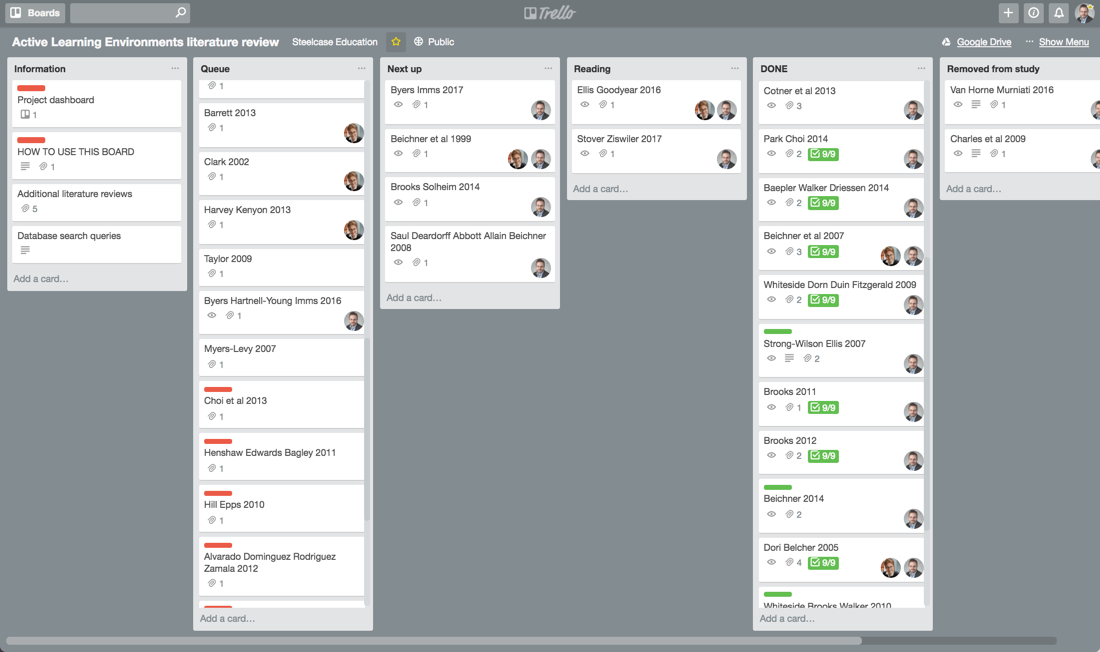Using Google Drive, Mendeley, Evernote, and Trello to manage a remote collaborative research project

Recently, I wrote about how GTD concepts have helped me stay relatively focused and productive as I read academic reseach articles. I need this because (a) I have a tendency to get bored and distracted when I read research and (b) the volume of reading that I am doing is at a high mark as I work on a literature review project for Steelcase. That brings me to another part of this process I wanted to detail, which is how I manage the workflow for doing research on a macro scale --- finding things to read, storing and organizing papers, and working productively with a remote collaborator on research.
The literature review project I am working on is one of the bigger projects that is emerging from my sabbatical. I am working with a Ph.D. student in Illinois to review all the empirical studies we can find on active learning spaces and their impact on student learning. Right now my collaborator and I have identified around 50 papers in this area that will need to be read, analyzed, synthesized, and eventually written about between now and February. The volume of work would necessitate a smart system for managing the information; having a remote collaborator lessens the workload on me but also introduces some logistical wrinkles I have to deal with. This post is about how I'm doing this so far.
The tasks and the tools
My collaborator and I have to do several things in preparing to write the review. First, we have to find papers to read, which means each of us needs a coherent system for storing and organizing digital documents. Second, we have to read these papers and take detailed notes on them for later categorization, which means we have to have a way to take notes and share them with each other so we don't end up duplicating effort. Third, we need a way to know which of us is reading which paper at any given time, not only to divide up the labor equitably but also in case I have a question about a paper that's been referenced in something I am reading, I can see if my collaborator has done any work with it.
To manage these tasks, I've enlisted the following tools:
- Google Drive for file storage
- Mendeley for management and organization of papers
- Evernote for notes
- Trello for project management
You probably know Google Drive and Evernote. Mendeley is my tool of choice for managing all my research papers --- there are other similar tools out there like Zotero but I gravitated to Mendeley early on and stuck with it. I like that it has macOS, iOS, and Android apps as well as a very good web interface, and its engine for recommending related papers to me is surprisingly on point. Finally, Trello is a visual information management app based on the kanban system. Longtime readers will remember this post where I described how to use Trello to make a real-time grading status board, and you can see some pictures and GIF's of Trello there.
Storing, reading, and taking notes
I find papers to read from a number of different sources. Once I have identified a paper that I believe merits closer reading (that determination is made by reading the abstract), I save it to Google Drive using a naming convention that I call "the universal naming scheme":
Names-of-Authors Year-of-Publication.pdf
So for example, the paper I wrote about in this post is stored in Google Drive as Baepler Walker Driessen 2014.pdf. Why Google Drive instead of Dropbox or something else? Last year, I discovered that my university offers unlimited Google Drive storage capacity if we use the GDrive account associated with our faculty GMail. So while I've used Dropbox as my main storage service for years, I have been moving more and more of my long-term storage to GDrive just because I can (and doing so gives me more free space on Dropbox). Otherwise there's nothing magical about Google Drive.
Once the papers are in Google Drive, a folder called Papers, they are automatically sychronized with Mendeley because I have designated Papers as a "watch folder" in Mendeley:

By using this option in Mendeley, any PDF added to that folder will be imported and synchronized without any further action necessary (unless I need to change any details that Mendeley's importer gets wrong). I can then use Mendeley to search, read, and annotate the papers. So that's several steps that I do not have to do manually, which is good.
When I do read a paper, I will do so in Mendeley but put my notes on the paper in Evernote. I create an Evernote note using the universal naming scheme --- same name as the PDF I am reading --- then add the citation for the paper (which can be generated using Mendeley) and take notes using the eight-part checklist that I introduced in the last post on this subject. Here's the note on the Baepler/Walker/Driessen paper I mentioned earlier if you want to see what it looks like. So each paper I am reading has notes for it that conform to a coherent structure.
Using Trello to pull it all together
I could really stop right here and have a decent, functional system for acquiring, reading, and annotating research. But with a remote collaborator (and just to keep myself organized) I also need something to track the process: Enter Trello. I've set up this board and added my collaborator as well as a couple of other Steelcase people who are interested in the project:

The board has lists for Information, Queue, Next Up, Reading, DONE, and Removed from Study. The categories are self-explanatory (and they are a lot like those on the Grading Status Board I mentioned earlier; in fact most of my Trello boards for projects have this structure). The way that the board gets used is like this:
- When either my collaborator or I finds a paper that merits study, we add it to the Queue by creating a card for it, titled using the universal naming scheme. We also add the PDF of the paper directly to the card --- crucially important because this way we can share files. I do this by using the Google Drive power-up for Trello which allows me to link directly to the paper in my Drive; my collaborator prefers to just drag-and-drop the PDF onto the card. Either way works.
- My collaborator and I both occasionally look in the queue and see if there are any papers that we specifically want to read. If I find one that suits me, I will claim it by adding myself as a "member" of that card. This puts my avatar on the card, letting my collaborator know that I'm doing that paper and she doesn't have to (and vice versa, if she claims a paper).
- When I claim a paper to read, I also add a checklist to the card that has the eight-step GTD process for reading on it. And as I read, I'll check off those boxes, both for my collaborator's sake (she can see where I am in the process) and for mine.
- When one of us decides on the papers that are next in line to be read, we move the associated cards to the Next Up list. Once the reading actually begins, we move it to the Reading list and start checking off checkboxes as we progress.
- Once I start taking notes on a paper --- which, remember, I do using Evernote --- I attach a link to the notes, using the Evernote power-up. This gives my collaborator a link to my notes updated in real time.
- Once the paper is actually read, the card is moved to the DONE list where it remains for later processing --- the PDF and the notes are right there for either of us to use.
What the Trello board provides is a real-time tracking list of what we're reading, who is reading what, and how far along we are in the process with complete access to both the article itself and our notes-in-progress on those articles. And it's in a package that can be accessed by either of us in any location on any device and updated in real time.
One more thing
To make things even more awesomely automated, I have set up an IFTTT applet that connects the Trello board to my ToDoist tasks. Using this applet, whenever anybody adds a new card to the Queue list on Trello, a corresponding task is placed in the "Active Learning Environments Literature Review" project I have set up in ToDoist. This automates the process of making sure that a paper in the queue translates into a task in my GTD system. (If my collaborator claims a paper, I'll delete the corresponding task from my ToDoist manually; also I add priorities and tags to the task manually since these can shift.)
But wait, you say, didn't you make a big deal out of saying that reading a paper is not a task but rather a project? I did indeed. So when I am ready to begin reading one of these papers --- which is a task in ToDoist now --- I go find it and add the eight steps for reading as subtasks. This turns the "task" into basically a small project, and I can check off the subtasks as needed.
Conclusion
I've been pretty happy with the way this setup has worked. My collaborator has jumped right in as well, noting for example that we can use the labelling feature on Trello to categorize the papers we are reading for later analysis in the literature review. It's provided a sensible, coherent, online-friendly framework for managing this large project that frees the brain space of my collaborator and me to think about bigger things.


